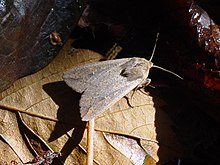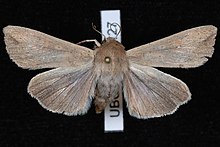| Mythimna unipuncta | |
|---|---|

| |

| |
| Scientific classification | |
| Domain: | Eukaryota |
| Kingdom: | Animalia |
| Phylum: | Arthropoda |
| Class: | Insecta |
| Order: | Lepidoptera |
| Superfamily: | Noctuoidea |
| Family: | Noctuidae |
| Genus: | Mythimna |
| Species: | M. unipuncta
|
| Binomial name | |
| Mythimna unipuncta (Haworth, 1809)
| |
| Synonyms | |
| |
Mythimna unipuncta, the true armyworm moth, white-speck moth, common armyworm, or rice armyworm, is a species of moth in the family Noctuidae. The species was first described by Adrian Hardy Haworth in 1809. Mythimna unipuncta occurs in most of North America south of the Arctic, as well as parts of South America, Europe, Africa, and Asia.[1] Although thought to be Neotropical in origin, it has been introduced elsewhere, and is often regarded as an agricultural pest.[2][3] They are known as armyworms because the caterpillars move in lines as a massive group, like an army, from field to field, damaging crops.[4]
The true armyworm has a distinct migration pattern in which they travel north in the spring and south in the fall to ensure that mating occurs in a favorable environment in the summer.[5] While progressing through the life cycle stages of egg, larva, pupa, and adult, this species must avoid attack from predatory bugs, birds, wasp and fly parasitoids, and bacterial and fungal diseases.[1] As polygamous insects, females release sex pheromones and choose multiple males as mates. The production and release of the pheromones are influenced by temperature, photoperiod, and the juvenile hormone.[6] Hearing is an important sense for the true armyworm, necessary for mating and evading bat predation.[7][8]
- ^ a b Cite error: The named reference
FLentwas invoked but never defined (see the help page). - ^ "Mythimna unipuncta (rice armyworm)". Invasive Species Compendium. CABI.
- ^ McLeod, Robin (October 29, 2018). "Species Mythimna unipuncta - Armyworm Moth - Hodges#10438". BugGuide. Retrieved July 4, 2019.
- ^ Palmer, Geoff (July 23, 2012). "Pest Alert - Armyworms Round Two Hit Hay and Corn Crops" Archived 2019-07-04 at the Wayback Machine. Agriculture and Market.
- ^ Cite error: The named reference
:1was invoked but never defined (see the help page). - ^ McNeil, Jeremy N. (1986). "Calling Behavior: Can It Be Used to Identify Migratory Species of Moths". The Florida Entomologist. vol. 69, no. 1, pp. 78–84. doi:10.2307/3494746.
- ^ Cite error: The named reference
:4was invoked but never defined (see the help page). - ^ Cite error: The named reference
:6was invoked but never defined (see the help page).